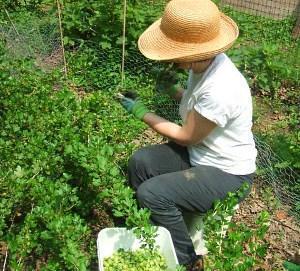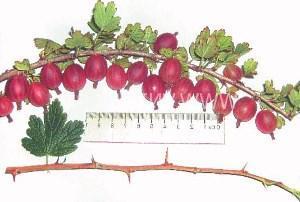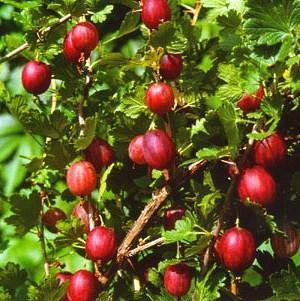The best gooseberry varieties and their specific features
 Each summer resident strives to plant only the best varieties of bush plants on his site, which can give a good and stable harvest. One of the favorite berries for many of our compatriots is gooseberry, which can be successfully grown throughout the territory of central and southern Russia. Given the high taste properties of the fruit, as well as the large composition of vitamins and minerals, many people want to see it on their site. However, in order to get a good harvest every year, it is important to find out the best varieties of gooseberries, as well as the features of its proper planting and growing.
Each summer resident strives to plant only the best varieties of bush plants on his site, which can give a good and stable harvest. One of the favorite berries for many of our compatriots is gooseberry, which can be successfully grown throughout the territory of central and southern Russia. Given the high taste properties of the fruit, as well as the large composition of vitamins and minerals, many people want to see it on their site. However, in order to get a good harvest every year, it is important to find out the best varieties of gooseberries, as well as the features of its proper planting and growing.
What to consider when choosing a gooseberry variety?
Today, a huge number of varieties of red gooseberries and amber yellow are presented on the domestic market, each of which has its own characteristics. It is important to consider here that you need to choose a suitable gooseberry variety based on the place of residence of a person, depending on the region and region, since each species has its own preferences in terms of climatic and soil conditions, temperature regime. Thus, the best gooseberry varieties for the Moscow region and the unique gooseberry varieties in Ukraine will be different, since the natural conditions here differ from each other.
Interesting photos of gooseberry varieties with a description
So, every summer resident quite reasonably seeks to choose such a variety of berry shrubs that will not only give a good and plentiful harvest, but also have good resistance to plant diseases. Extreme temperature drops, severe frosts, drought and other harmful factors can significantly reduce the immunity of a plant, which can cause its damage by pests. That is why if a person lives in Ryazan, Kostroma, Tula, Tver or another region lying at the same latitude, then the best varieties of gooseberries for the middle lane are best suited here.
Gooseberry variety Russian

This variety tolerates severe winter frosts, as well as summer drought, which makes it the most profitable option for many summer residents.
Correct spring pruning, which consists in cutting out old 5 and 6 year old shoots, gives a good result.
Date variety
 If you need to plant a variety where the number of thorns will be small, you can pay attention to the gooseberry variety Date, which is distinguished by its juicy pulp, dark red berries, and sweet taste.
If you need to plant a variety where the number of thorns will be small, you can pay attention to the gooseberry variety Date, which is distinguished by its juicy pulp, dark red berries, and sweet taste.
The high yield of the bush pleasantly pleases many summer residents, but here it is necessary to take into account the fact that the likelihood of being affected by powdery mildew in wet years increases significantly.
Gooseberry variety Komandor
 If you need to get berries of an average ripening period, you can pay attention to the Komandor gooseberry variety, which begins to bear fruit early enough. It is highly resistant to powdery mildew, as well as pests such as sawfly and septoria.
If you need to get berries of an average ripening period, you can pay attention to the Komandor gooseberry variety, which begins to bear fruit early enough. It is highly resistant to powdery mildew, as well as pests such as sawfly and septoria.
Its advantages include the following:
- High yield - 80-155 c / ha.
- Pleasant sweet and sour taste of berries.
- Counteracting major pests.
- Good winter hardiness.
- Few spines.
Large-fruited gooseberry varieties are usually put up for sale, since they are distinguished by their beauty, as well as good transportability, which is very important for many farmers.
The first large varieties of this plant were brought to our country from Europe, namely from Italy, where it was traditionally grown. However, they did not particularly take root, since they could not withstand the harsh domestic winters and today they are rarely used.
The following domestic species have gained high popularity among large varieties of gooseberries:
 Gooseberry Spring.
Gooseberry Spring.
This variety has large yellow berries with a fairly rich sweet taste. The universal way of using it makes it possible not only to eat it, but also to make jam from it and cook compotes. Gooseberry Jubilee.
Gooseberry Jubilee.
The variety was bred by a selective method, it is characterized by an average winter hardiness, which is why it is most often grown in the southern regions of Russia. The height of the bush can reach 1.5 m, so a trellis tie is very often required here. The berries are distinguished by their high transportability, and therefore they are freely grown not only by summer residents, but also by domestic farmers. Gooseberry Russian yellow.
Gooseberry Russian yellow.
It tolerates severe winters, has a spreading crown, has sweet and sour yellow berries of medium size. The early ripening period gives this species special popularity among many summer residents. The disadvantages include the low transportability of the plant, therefore, such gooseberries can most often be found on personal household plots, in dachas and vegetable gardens. Gooseberry Senator (Consul).
Gooseberry Senator (Consul).
Differs in high winter hardiness and good yield, as a result of which it is not afraid of spring frosts. The advantages of this gooseberry include good resistance to powdery mildew, as well as the soft and delicate taste of ripe berries. The berries are round, dark red, with a delicate skin, sweet and sour taste. The average yield of the variety is 5 kg / bush. This and other varieties of gooseberries for the Leningrad region are very common among summer residents of the Vologda, Novgorod, Pskov and other regions. Gooseberry Captivator.
Gooseberry Captivator.
It is a wonderful late-ripening variety bred in the USA. The berries have a brown-pink color, are distinguished by a rich sweetish-sour taste, well suited both for fresh consumption and for seaming.
Popular gooseberry varieties without thorns
The main disadvantage of traditional gooseberry varieties is their thorny bushes, which makes the process of picking berries very difficult and not very pleasant. However, our breeders have managed to develop unique gooseberry varieties that do not contain any thorns at all.
Gooseberry variety Kolobok
 One of them is the Kolobok gooseberry, the description of the variety of which should begin with berries, which are quite large and weighty. Usually, up to 10 kg of berries can be obtained from one large bush, and healthy and strong, since the variety is quite resistant to powdery mildew and anthracnose.
One of them is the Kolobok gooseberry, the description of the variety of which should begin with berries, which are quite large and weighty. Usually, up to 10 kg of berries can be obtained from one large bush, and healthy and strong, since the variety is quite resistant to powdery mildew and anthracnose.
The berries of this variety have a pleasant sweet and sour taste, have an oval shape and a dark red color. Even if the bush freezes a lot in winter, in the spring it easily recovers after proper pruning.
Varieties Malachite and Grushenka
Other popular varieties of thornless gooseberries include Malachite and Grushenka, which have a pleasant taste and even distribution throughout the bush. In general, their properties are very similar and the difference is only in the color and shape of the berries, since they are slightly elongated in Grushenka, and in Malachite they are of the correct round shape. For many summer residents, the thornless gooseberry varieties and photos of which can be found on the net are extremely popular.

However, it should be noted that any artificially bred thornless gooseberry, the varieties of which can be purchased in specialized stores, will not have such a rich taste as a regular one with thorns. That is why some summer residents prefer to buy traditional varieties and pick berries carefully.
Features of growing gooseberries in the Urals
Separately, a few words must be said about gooseberries, which are grown in Siberia, the Urals and the Far East. Despite the harsh climate, it is also possible to harvest this berry here, but for this it is necessary to use especially winter-hardy species. Such varieties of gooseberries for Siberia include Beryl, Harlequin, Kazachok, Ural emerald, Black Cherkashina and Krasny Vostok.
All varieties of gooseberries for the Urals must be planted correctly, as this will reduce the likelihood of damage to the inner root part in severe frosts. A bump of earth is necessarily poured around the root collar, and for the winter all the stems must be bent to the ground so that they are well covered with snow. This will provide reliable protection against severe frost.
Summing up the above, we can say that when choosing a gooseberry variety, the main thing is to be guided by the goals and objectives, since for industrial cultivation, you should choose well-transportable varieties, and for ordinary home use, take with excellent taste properties. In this case, the climatic features of a particular region must be taken into account.